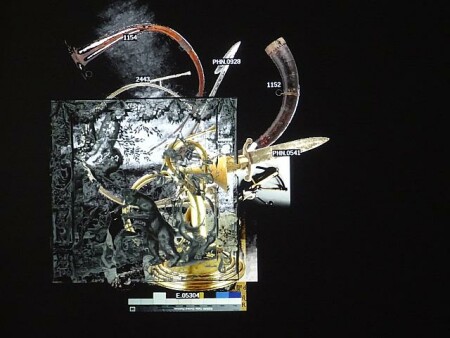DiVersions, cultural heritage done differently
DiVersions was an art project that experimented with digital cultural heritage. Various artists worked with metadata, databases, catalogues and digital infrastructures from the heritage sector to test new forms of collaborations, accentuate conflicts and provide different perspectives on familiar issues.
Challenge
Versions of heritage via versioning
Are facts ‘static’? This is the central question looked at in DiVersions. The project originally started in 2016 and was inspired by ‘versioning’ or ‘version management’, a method for dealing with divergence in networked collaborations. Log files and ‘diffs’ made the development process transparent, so attention could be paid to differences between the versions.

Atmospheric image from the DiVersions exhibition, Zoumana Meïté, Free Art License
This is also what DiVersions aims to do. Collections from cultural institutions (and their metadata) are usually seen as static works and objects. But the reality is often different, and metadata from these collections are subject to change. Over time, different versions of the datasets are created according to decisions made by museums when describing their collections. DiVersions therefore experiments with online collections from cultural institutions to make people more aware of these different versions so they can look at them from a different perspective.
Versioning can help with this by emphasising that each object in the collections was not created linearly but as part of a process. It can be used to show different versions and intervention points, and give people the possibility of looking critically at the various editions. And because digital collections can be used simultaneously in multiple contexts, it also gives us the possibility to research different perspectives on heritage, origin and ownership.
DiVersions 2.0
The project was relaunched in a second phase from 2019 to 2020, to delve deeper into the questions from the original work session. But a lot had changed between 2016 and 2019, and the project was taking place in a very different socio-political climate.
The discussion about the location of museums and archives was sparked by the AfricaMuseum renovation. This renovation resulted in the museum wanting to undergo a decolonisation process, which led to much criticism and more discussions, in particular around the question of whether an institution such as the AfricaMuseum, which was founded in 1910 as an agent of the Belgian colonial state and is sometimes called the ‘world’s last colonial museum’, can actually lead a decolonisation process in a critical way.
At the same time, more and more protests against racism and police brutality were taking place worldwide, even leading to an iconoclasm against statues of historical figures with links to the colonial past in 2020.
The potential of a project such as DiVersions became ever clearer in this context, and Constant vzw therefore decided to launch a new phase of the project.
Our role
DiVersions was coordinated by Constant vzw in collaboration with meemoo, ETWIE (expertise centre for technical, scientific and industrial heritage), Ghent University, RoSa (expertise centre for gender and feminism) and Werkplaats Immaterieel Erfgoed (WIE - ‘workplace for intangible heritage’).
We provided support around the re-use of cultural heritage and metadata from Wikimedia platforms in prototypes for the project. Constant vzw asked us to lead workshops and debates around re-use and different versions of heritage data.
Approach
In the second phase of DiVersions, we tested how versioning can be used to look at digital and digitised cultural heritage differently in seven artistic experiments. These seven projects were developed in consultation with each other and the partner institutions, and focussed on questions such as:
How can different versions of digital collections exist alongside each other?
How do we create space for future heritage, for issues that aren’t captured by museums and archives, and for things that are deliberately omitted?
How do we start the discussion around categorisation, colonisation and heritage?
How can online collections provide room for radically different or even opposing perspectives?
The seven installations created by the project were exhibited in De Pianofabriek (Brussels) in October 2019. You could see the installations here, together with the e-collections and their colonial and institutional constructions. A second exhibition from the project was scheduled for 2020 in collaboration with De Krook (Ghent) and Ghent University, but this was ultimately transformed into a digital exhibition as a result of the pandemic.
This change resulted in some of the artists having to rework their installations into a format that fitted in with a digital exhibition. For some projects, such as Het gewicht der dingen (The weight of things), the online exhibition was a logical next step in the research or even a possibility to expand the project, such as with Schetsmatige herkenning (Sketchy recognition), Diff3r3ntVversionsArePOSSIBLE?!., Collectie van onzekerheden (Collection of uncertainties) and When organic trees meet the data tree. For others, such as Een nieuwe browserceremonie (A new browser ceremony) and Material journeys through other realities, on the other hand, the installation approach had to be radically reconsidered.
The exhibitions were accompanied by a publication about the project produced in collaboration with Open Source Publishing. The project documentation was published via a wiki and on the DiVersions website.
Partners
Constant vzw (coordinator)
ETWIE (expertise centre for technical, scientific and industrial heritage))
RoSa vzw (expertise centre for gender and feminism)
WIE (workplace for intangible heritage)
- T • +32 9 298 05 01
- M • bart.magnus@meemoo.be
